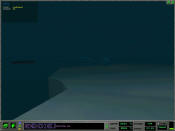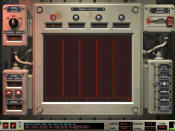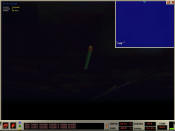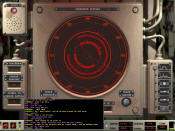|
SUB COMMAND |
![]()
Electronic Arts, Sonalysts
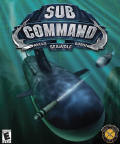
Witnessing a missile launch is a vital intel task |
Gone also are the days when the serious subsim aficionado groused that the game was too easy, the AI too predictable, and the campaign too scripted. One aspect of Sub Command that demands your attention from the start is the lengths Sonlaysts went to address shortcomings from Jane's 688(I). There are no magic upgrades to get a 40 knot prop. The sonar modeling is more advanced and stumped many players when the sim was first released. One example of the level of realism in Sub Command physics and sonar modeling: many players reported some screwy occurrences with their towed array sonar returns when transiting shallow waterways at low speeds. Turns out if you enter shallows and reduce speed to less than 3~4 knots, the towed array will drag the bottom and fill the broadband sonar with static!
One SEAL team to pick up |
When players of 688(I) argued that the campaign was too rigidly scripted, Sonalysts listened. Sub Command missions are scripted but they offer a wide range of randomness and variety. Producer Kim Castro says that a campaign needs direction to be something more than a series of "go hunt" missions. There's no way to accomplish that without some prepared mission design. But scripted does not have to mean playing the same mission with the same ships in the same places. A big part of a nuke subsim is detecting and performing Target Motion Analysis (TMA) on contacts. Sub Command scenario design allows for dynamic groups, probability of inclusion, and random placement. So the mission you play once could have a whole new set of ships and subs, each with different goals and ROE, in vastly different starting locations. You won't know where, who, or what as you replay the mission.
The missions in the stock campaigns follow a plot structure. Your patrols begin in peace time with surveillance and shadowing objectives and graduate into interdiction and full scale attacks. The missions replay in similar fashion but your performance has a dramatic impact on the following missions. I discovered this early in the campaign as the Seawolf sub. I was tasked with leaving port and transiting to a certain point undetected. The mission briefing advised of an enemy sub in the area and that I should try to detect it. The briefing stated I should avoid detection and, if possible, get a contact on any enemy vessels snooping in the area. This is the stuff nuke subsims are good at--stealth and intel gathering. I played the mission to success and was not detected. The next mission briefing mentioned my success and I began the next mission with a tactical advantage over the enemy units which were not aware of my presence. For a test, I went back and replayed the port egress mission, making sure I was detected by the enemy (wasn't hard, they were looking for me). When I started the following mission again the enemy units were fully aware of my presence and it made my job much tougher.
Target Motion Analysis is the heart of the game |
Sub Command sports three training missions, 23 single missions, and one 14 mission campaign. The campaign can be played from either the Russian or US side, so in effect there are two campaigns. The single missions are incredibly diverse. They range from search and rescue, battle group escort, tailing enemy boomers, spy missions, and general-purpose search-and-destroy. Many missions strictly prohibit firing on the enemy—you are expected to mirror real life Cold War objectives and get in—get out without being seen. Some missions offer you more than one choice of ownship submarine--you may play the mission as the Akula, 688(I), or the Seawolf. The three tutorial missions are very important if you have little experience playing a nuke subsim. The tutorials will coach you through maneuvers, using your periscope, sonar, ESM, radar, performing TMA, and getting firing solutions. Throughout the missions a voiceover gives you instructions and explanations. If you play the three training missions you will be ready to sample some single missions.
And when you have exhausted the stock of single and campaign missions, there is a first rate mission editor to create new missions. The mission editor provides a very complete set of tools to create random and dynamic missions with player and AI units that have specific goals. Completed custom missions can be locked with a password so that any player who downloads it will not be able to preview it in the editor--he'll have to play it to discover what is in store for him. You will never run out of missions for Sub Command. As the weeks pass, you can expect to see dozens, then hundreds of unique missions for the taking on the web. And then there's the tantalizing prospect of a random mission generator EA/Sonlaysts has mentioned in the near future.
Last but not least, there’s multiplay. Jane’s 688(I) brought subsim Internet multiplay to the masses and Sub Command raises the bar in this category as well. No more 688 vs. 688 battles. Now suspension of belief is reinforced with players commanding Russian subs opposing players in US subs. One of the realism options is Disable 3D and it makes up for the game-busting cheats employed by 688(I) players who choose to attach a 3D camera to their torpedoes and "improve" their TMA solution. Now the host can disable the 3D and Show Truth options.
| A close encounter at 200 meters |
The interface is improved with a collapsible station menu and the same speed, course, and depth mouse menus as with Jane’s 688(I). Sub Command borrows from its older brethren Fleet Command and incorporates drop-down menus in the plot screen that allow you to play as a war game. You could control your sub, target and launch weapons, and play the whole game from the Nav map if so desired, which may be a good starting point for novices.
Many aspects of the different screens among the three subs are uniform so you don’t have to memorize three vastly diverse environments. The buttons for most stations have the same symbol in the Seawolf and 688(I) as they do in the Akula. Nor do you need to speak Russian and read Cyrillic to play the Akula; the tags and labels have been rendered in English. The depths and distances measured in the Akula, however, do use the metric system while the US subs are still working with the English equivalents.
| At full realism, the map shows you only what you tell it to |
Yet with all the designed uniformity of the screens from one sub to another, many components and operational procedures differ. There’s a big difference in the sonar components between the Russian sub and the US subs, with the Akula’s broadband consisting of an orbital readout while the US subs have the more familiar (to us, anyway) waterfall displays. Configuring and launching the countermeasures in the Seawolf is not the same as in the 688(I). Coming to periscope depth in the Seawolf means 68 feet. When you switch over to playing the Akula, you need to remember PD is 15 meters. I found the data displayed by the broadband, narrowband sonar screens exceptional. Lines don't just pop into view, they are capable of fading in and out of view, depending on signal strength. Very nice! Overall, Sub Command boasts an impressive collection of screens and interfaces.
The game comes with a trim 32-page pamphlet that provides the essentials to playing the game. The main manual is as in-depth and concise as the old Jane’s manuals, except it's in .pdf format on the CD. Not the preferred format for a simulation as comprehensive as Sub Command. Two hundred pages in length, each station and every control, game options, sonar principles, weapons and vessel parameters are covered in detail for all three submarines. Tactics and gameplay tips are not included, so a beginner has less information than is ideal on how to play successfully. SUBSIM Review will endeavor to fill that need with our Tactics & Tips section (end plug). It pays to understand all the weapons and sonar stations well so accessing the manual is key. I printed mine out on a laser printer but you could pause the game and ALT-TAB minimize it to study the manual during a game. Sub Command is not an arcade game so subsim beginners will need to appreciate the concept of learning and patience.
Having three different subs featured lends longevity to Sub Command. The different capabilities and weapons loadouts require different strategies. Akula comes equipped with SSN-16-Stallion missile-propelled, air-dropped torpedoes that gives the Russian sub unmatchable sudden strike capabilities against enemy subs and the 65cm torpedo possesses incredible range—35 miles. Did I mention the 200 knot rocket torpedo, the VA-111 Shkval? Just the ticket for shaking up a sleepy Sub Command LAN party. The Seawolf has been given greater stealth attributes than either the 688(I) or the Akula and this gives it an edge over the armed-to-the-teeth Akula. The only ASW weapon in the American arsenal is the trusty old Mark 48 ADCAP. Seawolf packs eight tubes while the aging 688(I) can only launch 4 ASW weapons at a time. The Akula has eight internal tubes that can be reloaded and six external, one-shot-only tubes, for a hull-busting total of 14 tubes that can be brought to bear on target. The USNI profile for the Akula II also mentions a "Strela portable SAM system (18 missiles). Maybe Sonalysts can be coaxed into adding that in a later mod. Detection ranges are shorter than what you are used to in 688(I) and the torpedoes do not acquire unless you get them reasonably close to the target. An interesting aspect with having three identifiable classes of subs means that during a multiplay match players will need to avoid taking out one of their own. No more snapshots on first detected line of bearing, now you will need to complete identification on your contacts in multiplay. All together, Sub Command delivers some really wicked gameplay.
|
Your mission briefing |
Each sub has its own distinctive sounds. The Akula is more mechanical and solid, the Seawolf with its unique touch panels has an electronic feel. The 688(I) retains the basic sounds from the original game. The familiar torpedo flooding, button-clunking, and mast motor sounds make the veteran subsimmer feel right at home. The steady hum of the nuclear powerplant permeates the background. Voice acting is good.
Sonalysts have been steadily evolving the graphics used in their games. Sub Command represents a broad stride forward from 688(I) and outshines Fleet Command. With my nVidia TNT2 (32MB) card I was able to turn up all the detail with no slowdown of the game. The control panels are all unique and show an appreciable amount of thought and detail. I especially liked the Russian hardware with its braided cables, metal equipment tags, and mechanical sliding switches. The 688(I) is very much the same as before with some improved arrangements and a little extra color. The Seawolf panels and gauges are very hi-tech looking and are a complete departure from any nuke subsim before it. I found the Seawolf's button panels to be a little too layered, requiring more clicking than I would like to see. The Broadband sonar button matrix alone has five buttons (out of eight) that require a click to open a new subset button panel to perform a function. I haven't been in the sonar shack of a Seawolf class so I don't know if the real deal works this way but if not, I would gladly trade five big buttons for ten smaller buttons right up on top.
|
Superb graphic detail |
The 3D external and environmental views are just as good. The subs and ships are sharp and very detailed and exhibited no clipping. If a submarine exceeds cavitation speed, a dense cloud of microbubbles trails the screw or propulsor. Eject an active countermeasure and it will trail alongside you spewing bubbles until you break and distance it. Explosions are colorful and dynamic. When the periscope breaches the surface, a foamy film slides down the lens and tiny droplets of ocean spray peppers the glass--one of the best touches of graphic realism I’ve ever seen in a sub or naval sim.
There a few items that could use attention. Damage modeling is limited to a percent readout; you don't have the option to assign damage control parties or prioritize the work. Frank Kulick, an experienced submariner who writes for SUBSIM Review, said equipment failures aboard a submariner have a definite impact on operations. "Modern day boats would be more apt to have equipment failures. Electrical casualties would wreak havoc! Loss of a buss would kill sonar, or the plot would go down! Fire Control has to do a cold start. Loss of chill water was a serious casualty because Fire Control and Sonar would overheat and crash! A fire or hydraulic rupture that would cause the boat to lose all control surfaces for a few minutes. During a CM launch a flange ruptures causing flooding and the loss of one of the launchers for 15-20 minutes. A fire in the Electric Plant Control Panel causing a loss of all power except DC lighting. A hot run in the torpedo tube during a launch. Flooding from a torpedo tube during a launch."
Sub Command seems very nearly free of bugs. Up to date drivers are a must. One of the first items that players alerted Sonalysts to was the incessant 360° pinging of active torpedoes, even your own torpedoes when they were heading away from you. People found it hard to adapt to a sea full of active pinging and Sonlaysts addressed the flaw in a matter of days with a patch. The 1.01 patch also fixed a class of ships in the database and multiplayer language compatibility. Weapon loadouts are too high, according the Frank; 688(I) should loadout with 40 max and Seawolf 50 max. Sonalysts has assured SUBSIM Review that they are going to fix that in the next patch. They should also consider changing the way compressed air is rationed aboard the sub. In the sim, if you fire more than seven or eight weapons (easy to do in the Akula or Seawolf), you will use up your compressed air and need to snorkel to charge the air banks. In real life, when you shoot torpedoes, air is used but it is vented inside the sub where the air compressors can suck it back up and pack it back in the banks. So the need to ventilate is off here unless the sim just omits the internal recharging. Last, the options need to be locked once a multiplayer game starts.
Sonalysts has sought to accommodate a wide range of playing styles and player experience by building in some key realism options. Quick reloads, enable 3D views, show dead platforms, and AI assistants allow you to play the game in an easy mode if you choose. The "Show Truth" option allows you to see any and all ships, planes, subs, icebergs, mines, and helos in the region. Turning off all realism options puts the burden of processing contacts and initiating timely reloads squarely on you. And that’s where a big portion of the gameplay exists in a nuke subsim. If you’re new to this kind of game, here’s how it works:
| Seawolf active intercept display |
In a modern submarine, you must employ listening sensors (hydrophones) to locate other ships. You can’t see underwater and you rarely use the periscope or active sonar, they can give away your position to other hunters in the deep. Once you make a contact, it is part of your routine to change course a few times to get a more refined solution by listening from different angles to the contact. During the course of your TMA (Target Motion Analysis) work you will get an idea of the kind of vessel, its range, speed, and course. This takes a little work and skill, often a little luck. When you think you know what the contact is, and if it happens to be a viable threat, you set up a weapon and launch it. Here’s the kicker—if you play with full realism, the 3D viewer will only show you other ships as you have determined them. If your TMA is wrong, what you thought was a Typhoon missile sub may turn out to be a whale or a rusty freighter. Or you may have it right—it is an enemy sub—but you are so far off the range and course estimates that your torpedoes run right over the symbol you placed on the map with the ship thousands of meters away and taking aim at you. You can see how a first-time subsim player browsing the shelf at Best Buy can use these options. Playing at full realism is much less a game and more a simulation than ever before.
If you're a newbie and all this talk about realism and analysis is worrying you, despair not. To help you get a feel for TMA and sonar analysis, the game gives you the option of playing with AI Assistants (Artificial Intelligence). In addition to the Sonar, TMA, and Fire Control assistants you knew from 688(I), meet the Radar assistant. The assistants will plot contacts, work up a firing solution, and keep you informed of enemy positions. They will certainly help a casual player avoid being overwhelmed by multiple duties. Just don't expect the assistants to be really good at their job--they are merely adequate. If you want better performance, it's up to you to learn the game and take over the work.
 One more for good measure |
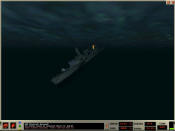 All ships can submerge; only submarines can surface |
 Periscope leaves a trailing feather of foam |
 Using the NAV map menu |
 Torpedo in the water! |
What is a game without good AI? A refund in the making. Sub Command has AI that is much more responsive to the player's actions than we knew in 688(I). In one mission, I switched on Show Truth and tried to get in the baffles of an enemy sub. He detected me and began evasive maneuvers that made it impossible to tail him. Subs will vary their speed and depth with some semblance of reason--no more 15 knot Kilos showing up as easy targets for you. Surface ships, when alerted to your presence, will launch ASW helos that comb the depths with dipping sonar. There are other neat real-life elements that will affect your performance in a mission. You can lose the wire unexpectedly. And Sub Command boasts a voice command system that actually works pretty well if you "train" the program. Speaking commands instead of clicking a mouse is pretty darn cool. Sub Command features a realistic ocean motion and wait till you see the weather effects--driving rain and lightening!
| Akula Broadband with multiplay chat extended |
One feature that must be mentioned is the arctic environments. Remember the intention to make an "Under Ice" add-on for Jane’s 688(I)? Sub Command makes it happen. And does it add to the gameplay! Prepare for a whole new ballgame. You think transiting littoral areas was tough, try making 6 knots though 200 feet of water, dodging iceberg keels and uncharted (as much of the arctic region is) underwater shelves and mountains. The Sub Command skipper must learn to navigate through dangerous three-dimensional mazes. Factor in time-based objectives (rescue a SEAL-smuggled nuclear scientist before he dies of exposure), enemy moored influence mines, and the possibility of a stealthy enemy sub hiding in the ice pockets and you have a real challenge, real tension, and real fun. Each sub has high-frequency sonar and forward/upward looking cameras and sensors for detecting ice and determining its thickness. To surface under the icepack, you need to have patience and a polynyas (thin spot in the ice) handy. One false move here and you and your crew are entombed forever in the polar wastelands.
Frank Kulick, a Chief in the U.S. Navy and the first web journalist to demo Sub Command last May described how Sub Command relates to his real life experiences: "After serving on three attack subs during the Cold War I was curious how the sim would stack up. I am definitely impressed and thoroughly enjoy the sim. It possesses the immersion, tension, and atmosphere I have experienced while on deployments (except field day cleaning). The extensive detail in the ocean environment is awesome and must be taken seriously to be successful. Real sonar and ocean environment study would be beneficial in the long run. The weapons in the sim perform and simulate superbly. A nice balance between game and real world. It did not contain the damage control screen I would have liked to see, but overall Sonalysts did a wonderful job!"
There you have it. Sub Command exhibits unprecedented levels of detail, complexity, good game design, and gameplay. The sonar modeling and TMA functions are meticulous. Everywhere you look, Sonalysts built in realism. Some games and simulations are knocked together and released as a blend of compromises. Sub Command is the exact opposite. Sonalysts has heard the call of players wanting the best in submarine simulations and they have delivered. The last naval/subsim to win SUBSIM Review's Pride of the Fleet award was Jane's 688(I) back in 1997. If you liked 688(I), you will love Sub Command—three times as much. Sub Command is the ultimate submarine simulation.
Rating: 96
| Realism | Historical Accuracy | Graphics | Sound/ Music | Game play | Repeat Play |
Stability /Bugs | Multi- play | Mission Editor |
| 18/20 | 9/10 | 10/10 | 10/10 | 19/20 | 9/10 | 8/10 | 5/5 | 5/5 |
| BONUS: +3: Support; +3: Three subs!; -3: No printed manual | ||||||||
Be sure to get the latest patch for Sub Command: Patch v1.08
****** Updated regularly ******
SUBSIM Newsletter reaches over 23,000 naval enthusiasts each month. Get the latest news and info on naval games, books, and subsims.
| Sub Command is available in the SUBSIM Store. | Sign up with Sub Command HQ and get started online: |
Go to the
PATCHES & MISSIONS
section to DOWNLOAD the latest patches for this sim.
Go to the TACTICS & TIPS section to DOWNLOAD the latest patches for this sim.
Guys who dig nuke subsim action have recommended the following as good reading:
- Big Red : Three Months on Board a Trident Nuclear Submarine by Douglas C. Waller
- Crazy Ivan: Based on a True Story of Submarine Espionage by W. Craig Reed, William Reed
- Blind Man's Bluff: The Untold Story of American Submarine Espionage by Sherry Sontag, et al
- Fast-Attack Submarine: The Seawolf Class (High-Tech Military Weapons) by Gregory Payan
Minimum Specifications.
Windows 95/98/98SE/Millennium Edition/2000
Pentium II 233Mhz
64MB RAM
Eight-speed CD-ROM drive
Direct 3D compliant Video Card with 8MB Video RAM
Sound Card (100% Windows Compatible)
Desktop Resolution of 640X480 @ 16-bit color depth minimum
590MB hard-drive space for installation.
Recommended System:
Pentium II 350Mhz
96 MB RAM
Direct 3D compliant Video Card with 16MB Video RAM
Desktop Resolution of 1024X768 @ 32 or 16-Bit.
850MB hard-drive space for installation.
PLATFORM: Win95SE/98/2000
Return to SUBSIM Review
©2001 SUBSIM Review







